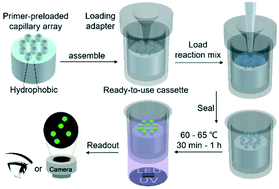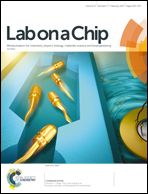Visual detection of multiple genetically modified organisms in a capillary array†
Abstract
There is an urgent need for rapid, low-cost multiplex methodologies for the monitoring of genetically modified organisms (GMOs). Here, we report a ![[C with combining low line]](https://www.rsc.org/images/entities/char_0043_0332.gif) apillary
apillary ![[A with combining low line]](https://www.rsc.org/images/entities/char_0041_0332.gif) rray-based
rray-based ![[L with combining low line]](https://www.rsc.org/images/entities/char_004c_0332.gif) oop-mediated isothermal amplification for
oop-mediated isothermal amplification for ![[M with combining low line]](https://www.rsc.org/images/entities/char_004d_0332.gif) ultiplex visual detection of nucleic acids (CALM) platform for the simple and rapid monitoring of GMOs. In CALM, loop-mediated isothermal amplification (LAMP) primer sets are pre-fixed to the inner surface of capillaries. The surface of the capillary array is hydrophobic while the capillaries are hydrophilic, enabling the simultaneous loading and separation of the LAMP reaction mixtures into each capillary by capillary forces. LAMP reactions in the capillaries are then performed in parallel, and the results are visually detected by illumination with a hand-held UV device. Using CALM, we successfully detected seven frequently used transgenic genes/elements and five plant endogenous reference genes with high specificity and sensitivity. Moreover, we found that measurements of real-world blind samples by CALM are consistent with results obtained by independent real-time PCRs. Thus, with an ability to detect multiple nucleic acids in a single easy-to-operate test, we believe that CALM will become a widely applied technology in GMO monitoring.
ultiplex visual detection of nucleic acids (CALM) platform for the simple and rapid monitoring of GMOs. In CALM, loop-mediated isothermal amplification (LAMP) primer sets are pre-fixed to the inner surface of capillaries. The surface of the capillary array is hydrophobic while the capillaries are hydrophilic, enabling the simultaneous loading and separation of the LAMP reaction mixtures into each capillary by capillary forces. LAMP reactions in the capillaries are then performed in parallel, and the results are visually detected by illumination with a hand-held UV device. Using CALM, we successfully detected seven frequently used transgenic genes/elements and five plant endogenous reference genes with high specificity and sensitivity. Moreover, we found that measurements of real-world blind samples by CALM are consistent with results obtained by independent real-time PCRs. Thus, with an ability to detect multiple nucleic acids in a single easy-to-operate test, we believe that CALM will become a widely applied technology in GMO monitoring.



 Please wait while we load your content...
Please wait while we load your content...